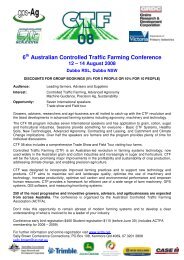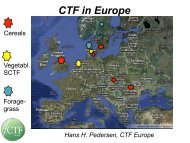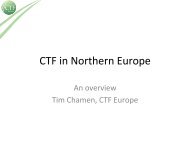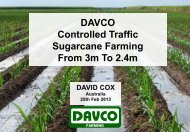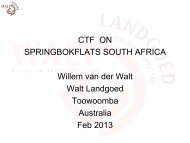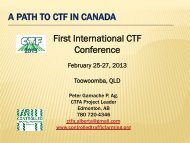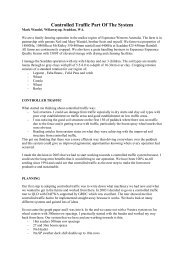CTF Impacts on Soil Biology - Pauline Mele , Dept of ... - ACTFA
CTF Impacts on Soil Biology - Pauline Mele , Dept of ... - ACTFA
CTF Impacts on Soil Biology - Pauline Mele , Dept of ... - ACTFA
Create successful ePaper yourself
Turn your PDF publications into a flip-book with our unique Google optimized e-Paper software.
C<strong>on</strong>trolled traffic farming - likely resp<strong>on</strong>ses & benefits<br />
for soil biota<br />
First Internati<strong>on</strong>al <str<strong>on</strong>g>CTF</str<strong>on</strong>g> C<strong>on</strong>ference<br />
<str<strong>on</strong>g>CTF</str<strong>on</strong>g>2013 25 - 27 February 2013<br />
Toowoomba Queensland
C<strong>on</strong>tent<br />
<strong>Soil</strong> Biota: much more than a numbers game<br />
The soil as a physical & chemical habitat<br />
C<strong>on</strong>trolled traffic farming: likely impacts <strong>on</strong> soil biota<br />
Opportunities for future work
Numbers<br />
………...in 1 gram <strong>of</strong> soil:<br />
• 10,000 - 50,000 species<br />
• 100-1000ug microbial biomass<br />
C; 4-45 t ha -1 !<br />
• 5-200 ug DNA; 1,598 km l<strong>on</strong>g!<br />
• > 1 milli<strong>on</strong> genes for N,C, P<br />
cycle, antibiotic producti<strong>on</strong> &<br />
pesticide degradati<strong>on</strong><br />
Nature Reviews Microbiology 9, 628 (September 2011) |
Numbers & size…..<br />
Group Comm<strong>on</strong> name Av Size Range Abundance (g soil)<br />
Micr<strong>of</strong>lora<br />
Viruses<br />
Bacteria<br />
50-100nm<br />
0.02-5µm<br />
10 10-20<br />
10 8-9<br />
Archaea<br />
0.5-3µm<br />
10 6-8<br />
Fungi<br />
2µm-1m<br />
10 4-6<br />
Micr<strong>of</strong>auna<br />
Protozoa<br />
5-200µm<br />
10 3-4<br />
Nematodes<br />
10µm-2mm<br />
10 2-3<br />
Mes<strong>of</strong>auna<br />
Collembola<br />
250µm-2mm<br />
10 2-3<br />
Mites<br />
100µm-2mm<br />
10 1-2<br />
Macr<strong>of</strong>auna<br />
Earthworms<br />
Beetles<br />
2mm-200mm<br />
(visible)<br />
.1-.5<br />
.1-.5<br />
Ants<br />
.2.-.4<br />
Termites<br />
.2-.5
=0.5mm
Microbial …in a teaspo<strong>on</strong> Community pr<strong>of</strong>iles<br />
(c<strong>on</strong>venti<strong>on</strong>ally tilled cropping soil)<br />
Unknown<br />
Other sequences<br />
Microbial life & side benefits <br />
Nutrient foraging <br />
Self preserva8<strong>on</strong>
nutrient foraging <br />
Extracellular enzyme producti<strong>on</strong><br />
P cycle: phosphatases & phytases<br />
C cycle: phenol oxidases (laccases),<br />
peroxidases & dehydrogenases,<br />
methane m<strong>on</strong>ooxygenase<br />
N cycle: amm<strong>on</strong>ia<br />
m<strong>on</strong>ooxygenases, nitrogenases<br />
Burns et al <strong>Soil</strong> Biol Biochem 2013
Community func8<strong>on</strong>s (bacteria) <br />
Archaea, 1%<br />
(57% MCR)<br />
own 27%<br />
1% MCR)<br />
Crenarchaeota<br />
Deinococcus-Thermus<br />
Spirochaetes<br />
Bacteria 71% Epsil<strong>on</strong>proteobacteria<br />
(51% MCM)<br />
Cyanobacteria<br />
C-cycle<br />
N-cycle<br />
P-cycle<br />
Bioremediati<strong>on</strong><br />
Methanogenesis<br />
Chlor<strong>of</strong>lexi<br />
Planctomycetes<br />
Betaproteobacteria<br />
Gammaproteobacteria<br />
Acidobacteria<br />
Firmicutes<br />
rhizobia <br />
Deltaproteobacteria<br />
Bacteroidetes/Chlorobi<br />
Alphaproteobacteria<br />
Actinobacteria<br />
0 20 40 60 80<br />
<strong>Mele</strong> et al (in preparati<strong>on</strong>)
Side benefits eg Biological N 2 Fixati<strong>on</strong> (BNF)<br />
N 2 Gas <br />
NH 4<br />
+ <br />
example benefit $ value<br />
Symbiotic N-<br />
fixing bacteria<br />
(eg rhizobia)<br />
2.7 Mt N annually;<br />
equivalent to 3.4 Mt<br />
fertiliser N*<br />
4.3B<br />
annually*<br />
N<strong>on</strong> symbiotic<br />
N-fixing<br />
bacteria<br />
Fix between 10–<br />
70kg/ha<br />
(At Av<strong>on</strong>,SA, under an<br />
intensive wheat rotati<strong>on</strong>,<br />
NSNF provided 30–50% <strong>of</strong><br />
the total l<strong>on</strong>g-term N<br />
requirement) Vadakattu pers<br />
comm<br />
20-100/ha<br />
*From: INOCULATING LEGUMES: A PRACTICAL GUIDE (DRAFT)<br />
Ross Ballard, Roz Deaker, Matt Dent<strong>on</strong>, Liz Drew, Greg Gemell, Elizabeth Hartley, David Herridge,<br />
John Howies<strong>on</strong>, Graham O’Hara, Lori Phillips, Nikki Seymour, R<strong>on</strong> Yates, Neil Ballard
Self preserva8<strong>on</strong> <br />
Glycoprotein (Glomalin) producti<strong>on</strong> (green fluorescence)<br />
fungus<br />
bacteria<br />
exopolysaccharides (EPS)<br />
Increases c<strong>on</strong>tact between microbe (fungus and bacterium) and envir<strong>on</strong>ment;<br />
provides a protective shield against predators & dessicati<strong>on</strong>
Side benefits <br />
EPS produc8<strong>on</strong> results in surface <br />
crus8ng reducing wind & water <br />
borne erosi<strong>on</strong> <br />
Hyphal enmeshment & Glomalin <br />
produc8<strong>on</strong> results in aggregate <br />
forma8<strong>on</strong> & beHer structure
Value: Ec<strong>on</strong>omics <strong>of</strong> soil organisms in key processes <br />
Ac-vity <br />
Waste recycling <br />
<strong>Soil</strong> forma8<strong>on</strong> <br />
Nitrogen fixa8<strong>on</strong> <br />
Bioremedia8<strong>on</strong> <strong>of</strong> <br />
chemicals <br />
Biotechnology <br />
Bioc<strong>on</strong>trol <strong>of</strong> pests <br />
Total <br />
World ec<strong>on</strong>omic benefits <strong>of</strong> <br />
biodiversity (x $10 9 / year) <br />
760 <br />
25 <br />
90 <br />
121 <br />
6 <br />
160 <br />
1,162 <br />
Zechmeister et al (pers com)
Basic soil requirements for growth & survival <br />
• Gas exchange (O 2 -‐CO 2 ) <br />
• Water availability <br />
• Organic maHer (c<strong>on</strong>taining C,N,P) <br />
• Access to organic maHer <br />
• Habitable pore space
‘Habitable pore space’ <br />
• Suggests a relati<strong>on</strong>ship between the size <strong>of</strong> organisms and the<br />
z<strong>on</strong>es <strong>of</strong> soils they are physically able to inhabit (Young & Ritz<br />
2000).<br />
• It relates to size <strong>of</strong> the neck <strong>of</strong> pores enabling water exchange,<br />
providing refuge from predators, and accessibility to food (Elliot<br />
et al 1980)<br />
• Primarily a feature <strong>of</strong> soil texture & also physical disrupti<strong>on</strong> (eg<br />
tillage & wheel traffic)
<strong>Soil</strong> as a physical habitat: <br />
• 3 phases<br />
Solid <br />
Liquid <br />
Gaseous <br />
• Architecture <br />
0.5mm <br />
Network <strong>of</strong> pores <strong>of</strong> <br />
different shapes & sizes: <br />
Highly dependent <strong>on</strong> <br />
texture & compac-<strong>on</strong> <br />
Powerpoint Presenta-<strong>on</strong>: Life from <strong>Soil</strong>, text and images Thomas <br />
Fester, hNp://www.ufz.de
Larger par8cles give larger pores in an iden8cal volume <br />
pores<br />
.2-1.2µm<br />
6-30µm, 30-90µm<br />
Powerpoint Presenta-<strong>on</strong>: Life from <strong>Soil</strong>, text and images Thomas <br />
Fester, hNp://www.ufz.de
<strong>Soil</strong> as a physical habitat: <br />
Biota live in pores <br />
Nematodes >30µm<br />
Bacteria
Young & Ritz (2000) <strong>Soil</strong> & tillage research
Dry soils: <br />
Large pores drain first <br />
Plants wilt <br />
Nematode abundance <br />
declines markedly, <br />
protozoa less so <br />
0.5mm <br />
Bacteria survive in thin <br />
water films in larger pores <br />
>30µm and in water filled <br />
smaller pores (3µm) <br />
Powerpoint Presenta-<strong>on</strong>: Life from <strong>Soil</strong>, text and images Thomas <br />
Fester, hNp://www.ufz.de
Wet soils: <br />
Gas exchange <br />
blocked <br />
O 2 unavailable for <br />
bacterial & fungal <br />
respira8<strong>on</strong> & <br />
mineralisa8<strong>on</strong> <br />
0.5mm <br />
Predators increase: eg <br />
Nematodes & protozoa <br />
Powerpoint Presenta-<strong>on</strong>: Life from <strong>Soil</strong>, text and images Thomas <br />
Fester, hNp://www.ufz.de
Moyano et al <strong>Soil</strong> Biol Biochem 2013
Hassink et al 1993
<str<strong>on</strong>g>CTF</str<strong>on</strong>g>: likely impacts <strong>on</strong> soil biota
Spectrum <strong>of</strong> impacts <strong>on</strong> soil biota<br />
high<br />
low<br />
<strong>Soil</strong> type > climate > crop rotati<strong>on</strong> > tillage/compacti<strong>on</strong>, lime, fertilisers, manures, pesticides,<br />
inoculants<br />
C<strong>on</strong>trolled by<br />
envir<strong>on</strong>ment<br />
C<strong>on</strong>trolled by landholder
<str<strong>on</strong>g>CTF</str<strong>on</strong>g>: supporting evidence <strong>of</strong> impacts<br />
SCOPUS Literature search<br />
Search terms<br />
1986 1996 2002 2005 2007 2008 2009 2010 2011 2012<br />
Years
<str<strong>on</strong>g>CTF</str<strong>on</strong>g>: likely impacts<br />
• Level <strong>of</strong> impact <strong>on</strong> soil structure :<br />
higher<br />
lower<br />
Wheeled tillage >wheeled no-tillage> c<strong>on</strong>trolled traffic no-tillage<br />
• If <str<strong>on</strong>g>CTF</str<strong>on</strong>g> results in better structure (lower bulk density/less compacti<strong>on</strong>)<br />
compared to tillage then it can be assumed that this will also impact <strong>on</strong><br />
microbial properties
Management opti<strong>on</strong>s to increase food supply<br />
More SOC<br />
Organic matter & other <strong>of</strong>fsite additi<strong>on</strong>s (H)<br />
(No tillage & stubble retained & c<strong>on</strong>trolled traffic)<br />
Pasture cropping (M)<br />
(No tillage& stubble retained & c<strong>on</strong>trolled traffic)<br />
Rotati<strong>on</strong> with pasture (H)<br />
(No tillage & stubble retained & c<strong>on</strong>trolled traffic)<br />
C<strong>on</strong>trolled traffic (M)<br />
(No tillage & stubble retained)<br />
No tillage & stubble retained (M)<br />
Reduced tillage (M)<br />
(stubble removed)<br />
Tillage, stubble removed (M)<br />
L<strong>on</strong>g Fallow & Tillage &<br />
Stubble removed (M)<br />
(burnt, grazed/baled)<br />
Less SOC<br />
Figure 1. Cropping practice and relati<strong>on</strong>ship with expected <strong>Soil</strong> Organic Carb<strong>on</strong> levels. C<strong>on</strong>fidence in SOC benefit<br />
based <strong>on</strong> qualitative assessment <strong>of</strong> theoretical & evidentiary lines; L=Low, M=Medium, H=High (adapted from<br />
Sanderman et al 2010, Scott et al 2010 and Murphy et al 2011).
Evidence for organic matter improvements (wheeled no-till vs<br />
wheeled till)<br />
Factor no-‐-ll vs -ll reference <br />
Substrate quality <br />
& quan8ty <br />
More organic C and Total N <br />
Murphy et al (2011) <br />
Hoyle & Murphy (2011) <br />
C<strong>on</strong>yers et al (2012) <br />
More carbohydrates, amino acids, <br />
alipha8c C & less aroma8c C <br />
Arshad et al (1990), Shulten et al <br />
(1990)
Evidence for structural change (influence <strong>on</strong> protecti<strong>on</strong> and nutrient accessibility)<br />
Factor no-‐-ll vs -ll reference <br />
Pores <br />
More pores <strong>of</strong> biological origin (eg <br />
earthworms, root channels) <br />
Hendrix et al 1987; Shipitalo & <br />
Protz 1987; Drees et al 1994; <br />
Carter et al 1994; <strong>Mele</strong> & Carter <br />
1999 <br />
Aggregates <br />
More pores 200 µm <br />
Shape differences: round pores <br />
twice as abundant & el<strong>on</strong>gated <br />
pores half as abundant, more <br />
homogeneous (pore shape) <br />
Aggregate sizes have generally been <br />
found to be greater <br />
Bo<strong>on</strong>e et al 1976 <br />
Shipitalo & Protz (1987) <br />
Pagliai & De Nobili (1993) <br />
Drees et al., 1994; Lal et al., <br />
1994
Evidence for biological change<br />
Factor no-‐-ll vs -ll reference <br />
Access to substrate more Foster 1994 <br />
Microbial biomass more Interna'<strong>on</strong>al: <br />
Doran, 1980, 1987; Lynch and Pan8ng, <br />
1980; McGill et al., 1986; Granastein et <br />
al., 1987; Buchanan and King, 1992 <br />
In Australia: <br />
Haines & Uren 1990 <br />
<strong>Mele</strong> & Carter 1999 <br />
Hoyle & Murphy 2011 <br />
Decomposer fungi more Coleman 1994 <br />
Fungal c<strong>on</strong>tribu8<strong>on</strong> to the <br />
forma8<strong>on</strong> & stabilisa8<strong>on</strong> <strong>of</strong> <br />
aggregates* <br />
more <br />
Beare et al., 1992 <br />
Decomposer bacteria less Coleman 1994 <br />
Earthworms more Atlanvinyte, 1964; Parmelee et al., 1990; <br />
Francis & Knight, 1993; Fraser, 1994, <br />
Baker et al 2006, <strong>Mele</strong> & Carter 1999 <br />
Nitrifiers more Murphy pers com
Microbial biomass carb<strong>on</strong> at six paired new land/old land <br />
sites in Queensland, Australia <br />
Site and loca8<strong>on</strong> <br />
Microbial biomass (ug C g-‐1 soil) <br />
New land <br />
Old land <br />
Tully 591 (155)* 357 (45) <br />
Costanzo 590 (279) 519 (295) <br />
Harney 192 (20) 216 (11) <br />
For8ni 372 (57)*** 125 (14) <br />
Ingham 732 (73)*** 313 (65) <br />
Kalamia 336 (134)* 160 (70) <br />
Pankhurst et al 2003
New opportunities<br />
• <str<strong>on</strong>g>CTF</str<strong>on</strong>g> should support the ‘op8mal range <strong>of</strong> biological func8<strong>on</strong>s’ for a given <br />
soil type (texture class); this should be quan8fied: <br />
• design a 4-‐D (8me is the 4 th ) framework that links the biological func8<strong>on</strong>s <br />
opera8ng in the pore space (µm) to the field space (m) <br />
-‐eg underground maps linked to <br />
• ensure that the physical chemical and biological measures used for <br />
interpre8ng the impact <strong>of</strong> <str<strong>on</strong>g>CTF</str<strong>on</strong>g> are taken at the same scale; the scale <br />
dependency <strong>of</strong> measures o8en means we are comparing apples with oranges that <br />
d<strong>on</strong>’t progress mechanis'c understanding related to impacts <strong>of</strong> <str<strong>on</strong>g>CTF</str<strong>on</strong>g> <br />
-‐ eg the scale at which moisture and physical proper8es measured is <br />
different to scales at which microbial ac8vity occurs
New opportunities<br />
• Tools are available for assessing soil biota and are already <br />
being applied across several industries (GRDC, SRDC, DA, <br />
-‐ DNA extrac8<strong>on</strong>& sequencing technology is now cheaper than <br />
ever! <br />
• M<strong>on</strong>itoring frameworks are in place: <br />
www.soilquality.org.au <br />
www.bioplanorms.com.au/special-‐ini8a8ves/envir<strong>on</strong>ment/soil-biodiversity
BASE: Biome <strong>of</strong> Australian soils<br />
Agricultural sites <br />
Na8<strong>on</strong>al/state park sites <br />
http://www.bioplatforms.com.au/special-initiatives/envir<strong>on</strong>ment/soil-biodiversity
Further informati<strong>on</strong><br />
Know where to find further informa8<strong>on</strong>. <br />
• hHp://www.soilquality.org.au <br />
• hHp://www.bioplanorms.com.au/special-‐ini8a8ves/envir<strong>on</strong>ment/soil-biodiversity<br />
<br />
GRDC <strong>Soil</strong> <strong>Biology</strong> Ini8a8ve-‐II (2009-‐2014) <br />
• hHp://www.grdc.com.au/soilbiology



